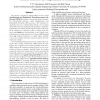Free Online Productivity Tools
i2Speak
i2Symbol
i2OCR
iTex2Img
iWeb2Print
iWeb2Shot
i2Type
iPdf2Split
iPdf2Merge
i2Bopomofo
i2Arabic
i2Style
i2Image
i2PDF
iLatex2Rtf
Sci2ools
ISCA
2002
IEEE
2002
IEEE
Transient-Fault Recovery Using Simultaneous Multithreading
We propose a scheme for transient-fault recovery called Simultaneously and Redundantly Threaded processors with Recovery (SRTR) that enhances a previously proposed scheme for transient-fault detection, called Simultaneously and Redundantly Threaded (SRT) processors. SRT replicates an application into two communicating threads, one executing ahead of the other. The trailing thread repeats the computation performed by the leading thread, and the values produced by the two threads are compared. In SRT, a leading instruction may commit before the check for faults occurs, relying on the trailing thread to trigger detection. In contrast, SRTR must not allow any leading instruction to commit before checking occurs, since a faulty instruction cannot be undone once the instruction commits. To avoid stalling leading instructions at commit while waiting for their trailing counterparts, SRTR exploits the time between the completion and commit of leading instructions. SRTR compares the leading and...
| Added | 15 Jul 2010 |
| Updated | 15 Jul 2010 |
| Type | Conference |
| Year | 2002 |
| Where | ISCA |
| Authors | T. N. Vijaykumar, Irith Pomeranz, Karl Cheng |
Comments (0)

